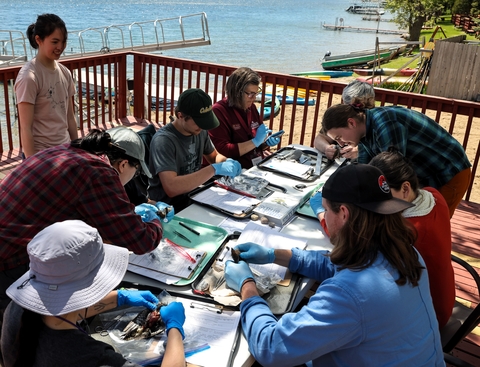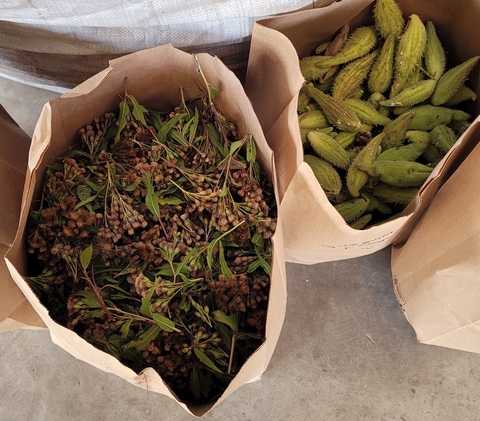Minnesota Master Naturalist volunteers help rebuild native plant communities
Each week throughout the summer, Minnesota Master Naturalist Bill Armstrong winds his way through the rustling grasses and flowers of Dodge Nature Center’s prairie.
He enjoys the solitude, learning about the state’s native plants, and the full-sensory experience of gently collecting seeds. He might smell the licorice scent of anise hyssop, spicy bergamot or mountain mint. If he listens closely, he might also hear wild lupine seeds that ripen in their pods and explode when ready.
“You can hear them popping,” he says. “It’s really fun when they’re doing that.”
Many plants, many pollinators
Regional, county and state parks often welcome and depend on University of Minnesota Extension Master Naturalist volunteers for the labor-intensive tasks of collecting seeds to help restore prairie. The drought-hardy prairie ecosystem once covered 18 million acres of Minnesota. Restoring native plants undaunted by drought and able to thrive after fire becomes even more important as the climate changes and people recognize the importance of biodiversity.
Dodge Nature Center’s prairie between Mendota Heights and West St. Paul has at least 50 varieties of native plant species after decades of work. That effort ensures something is always blooming and offering nourishment for pollinators, which are essential to grow nearly everything we eat.
“Greater plant diversity attracts a broader diversity of insects, including the endangered rusty-patched bumble bee,” says Pete Cleary, Dodge Nature Center’s environmental education director.
Some pollinators require specific plants to survive, such as wild lupine for federally endangered Karner blue butterflies or echinacea for threatened Dakota skipper butterflies. Monarchs seek blazing star and purple prairie clover — not just milkweed.
All hands on deck
“In Minnesota, we’re very lucky to have a lot of native-seed vendors, but it gets pretty expensive, and some seeds aren’t commercially available,” says Sara Vacek, wildlife biologist with the Morris Wetland Management District, part of the U.S. Fish and Wildlife Service. She and the staff have been able to acquire and plant about 90 native species near their office headquarters in western Minnesota’s prairie pothole region.
“We restore a few hundred acres of grasslands each year,” she says, but they may never recover the past level of prairie-plant diversity. “We call it a ‘prairie reconstruction.’”
Volunteers seed collectors can target specific plants during the season from early-blooming pasqueflowers and prairie smoke to late-blooming asters and bottle gentian. The busiest time for seed collecting stretches from August through October. On National Public Lands Day in September, Minnesota Master Naturalists can be found volunteering across the state.
Sharing knowledge and nature
Anyone can join the Minnesota Master Naturalist Program by completing 40 hours of training through Extension. Some, like Armstrong, choose seed collecting as a capstone project. They can also mentor others to identify native plants and discern when seeds are ready.
“It changes week to week,” says Cleary. “Something’s always ready or blooming.”
Picking a single seed pod too early could waste up to 500 seeds. Waiting too long could mean missing out. Prairie phlox and spotted touch-me-not (also known as jewelweed) have pods that explode to scatter seeds like lupine. Butterfly weed pods split open to blow in the wind, and the tiny spear-like Indian-grass seeds can curl in the humidity, drop to the ground and corkscrew into the soil.
Like any harvest, the number of seeds can vary depending on that season’s weather. When a collection is bountiful, excess seeds are often shared with other parks, schools, and even nearby homeowners interested in starting a pocket of prairie or a pollinator garden.
“Minnesota Master Naturalists may not see the benefits of their work right away, but they still keep doing it and teaching others,” says Amy Rager, Extension educator and volunteer manager for the program.
No matter the size, any parcel of native habitat adds to the state’s biodiversity. Volunteering to collect seeds can boost those efforts.
For volunteers like Armstrong, it’s also an enjoyable and purposeful way to get out in nature without traveling far from home.
“I just like the ongoing learning,” says Armstrong. “It’s really a great walk on the prairie.”
How to collect native seed
- Check local parks or organizations for volunteer applications.
- Get permission before collecting wild seed on public or private properties.
- Harvest when weather has been dry or later in the day so morning dew or frost can dissipate.
- Know which plants you are seeking and be able to identify them.
- Harvest only a third or half of the ripe seeds. Allow others to naturally reseed.
- Many seeds can be easily collected by tapping stems or pods with seeds above a bag or envelope.
- Carry an easy-to-tote container, bin or bag with handles and pre-labeled paper envelopes or paper lunch bags for multiple species. Plastic bags can trap moisture and compromise seed quality.
Permission is granted to news media to republish our news articles with credit to University of Minnesota Extension. Images also may be republished; please check for specific photographer credits or limited use restrictions in the photo title.




